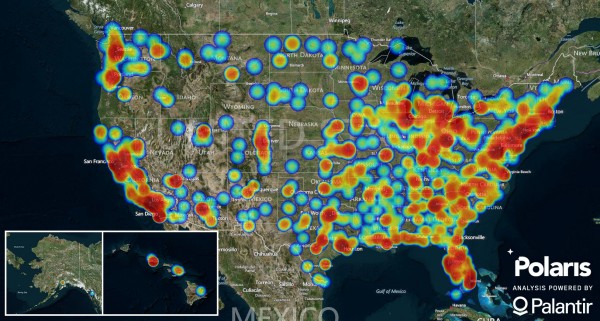Human trafficking has been a global issue for many years and continues to increase. Many people think that most of the trafficking happens overseas, but there is plenty taking place in the United States. Sometimes, healthcare providers are the only professionals to interact with victims throughout the process. Because of this, recognizing human trafficking in healthcare is very important.

This map reflects cases of human trafficking reported to the National Human Trafficking Hotline in 2016 where the location was known.
Both labor and sex trafficking are tough on physical and mental health, so it is likely that victims will seek medical attention at some point. Many professionals have trouble recognizing human trafficking in healthcare, but facilities are working to increase training. Here are some background statistics:
- 7,572 human trafficking cases in the United States were reported in 2016
- Over 31,600 cases were reported to the National Human Trafficking Hotline in the last 8 years
- 88% of survivors reported having contact with the healthcare system while they were trafficked
- In a survey conducted by Physicians Against the Trafficking of Humans (PATH), over 70% of physicians reported that they would not know what to do if they were confronted with a victim of trafficking.
Human Trafficking in Healthcare
Every person in a healthcare setting has the chance to detect and help victims. ER clinicians, primary care doctors, gynecologists, and psychiatrists are just a few of the professionals a victim might see. Although more and more medical professionals are receiving training to detect signs of trafficking, not all physicians really know what to look for. Individuals involved in trafficking are more likely to get help if human trafficking screenings become a regular part of appointments.
Recognizing Human Trafficking: Warning Signs
Physicians and healthcare professionals should look for the following:
- Malnutrition/dehydration
- Bruising, scars, burns, and cuts – especially those in non-apparent places
- Anxious, fearful, or depressed
- Multiple STD or pregnancy tests
- Cash payments with no insurance
- Substance addiction or withdrawal symptoms
- Tattoo of a name or strange symbol
- A third party speaking for the patient (sometimes acting as an “interpreter”), not allowing them to speak for themselves
In addition to noticing these warning signs, it is important for professionals to ask and listen to the stories behind them. These signs could be symptoms for anyone, victim or not, but hearing the details could reveal a deeper issue.
Intervention Techniques
There are many ways in which a physician or healthcare professional could react to the discovery that they are treating a trafficking victim. It is important to remember these techniques to provide the best help.
Stay calm
If your patient decides to share their situation with you, don’t react in the moment or act shocked. This could scare the patient or suggest disgust toward the victim. If a victim does not feel comfortable, it is likely they will not disclose anything else to you.
Prescribe a follow-up
Write your patient a prescription for a follow-up appointment for the medical issue. If they do not regularly see a doctor, this might be the only chance you have to see them again and help.
Get the patient alone
If your patient has a third party present, it would greatly help to get the victim alone. The elimination of the third party gives the patient more control and involves them more in answering questions. It can also give them a chance to speak up about their situation if they wish to.
Ask if they want police involved
As a physician, assure confidentiality unless the victim is a minor and you are a mandatory reporter. The victim might be fearful that his/her family is in danger if a report is filed, so be sure to talk with them.
Intervening can be very complicated, and gaining the patient’s trust is key. Communicating with the patient that you want to help and won’t force them to do anything they don’t want to will help them believe that someone really does care about them.
In addition to these guidelines, The Human Trafficking Hotline offers different online training courses for recognizing human trafficking in healthcare and intervening effectively.
